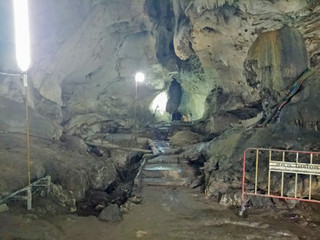War Atrocities: Death Railway in Thailand
- Achin Jain

- Jun 3, 2020
- 4 min read
Updated: Jun 3, 2020
Disclaimer: This is a story about the popular tour of the Death Railway in Thailand. In this story, I have described the war events and atrocities inflicted on POW. Some readers may find the gruesome details disturbing. Parental discretion suggested.
History, despite its wrenching pain, cannot be unlived, but if faced with courage, need not be lived again. ~Maya Angelou
I remember in our school textbooks taught us that the US bombed the cities of Hiroshima and Nagasaki because Japan was torturing prisoners of war (POW). I had a glimpse of Japanese warfare in the Netflix documentary on WWII, and how they were determined to fight till the end. I experienced the atrocities of WWII and the worse of mankind the day I explored the Death Railway in Kanchanaburi, Thailand.

Death Railway is a 415 km link between Ban Pong, Thailand, and Thanbyuzayat, Burma, that was built by Japan using POW and slave labourers during the WWII (1940-44). The track is no longer in use (except for some short sections for tourist trains) but continues to exist out of respect to the dead soldiers that built the railway. During the British colonisation of Burma, the railway project was surveyed by the British but discarded because, of the hilly terrain and river passes, they considered it to be too difficult to undertake. After defeating the British, the Japanese took hold of Burma and decided to go ahead with building the track. The idea was to invade deep into India and build a robust supply chain for Japanese war efforts.
The railway is termed Death Railway because countless soldiers lost their lives in building of the railway track. Official death estimates vary from 110,000 to 498,000. Imagine twelve persons died to build ten metres of the railway track. No matter the actual death toll, the fact remains that humans have to capacity to inflict this horror on our fellow human beings.
A small part of the track is operational for two tourist trains daily which runs from Bangkok to Kanchanaburi.
The train passes close to the mountain which was chiselled by light tools and dynamite. No heavy equipment was provided to the prisoners.


On the mountain side of this stop was the Wat Kra Sae Cave that was used as a temporary hospital to treat people. Now it is an empty space with a Buddha Shrine.
The Bridge on the River Kwai is the most popular section of the railway track. The section where I am standing in the picture below was destroyed by an airdropped bomb during the war. The rest of the bridge has an arc design, but this section was rebuilt with a straight design. This bridge has inspired a 1957 Hollywood movie by the same name. Although the movie is now a classic, our guide told us that it is not factually correct.

Across the bridge is the JEATH War Museum. This is where you leave with a heavy heart. Respectfully, I did not take any pictures inside. The museum building is a long bamboo hut, the kind POW had to live in. It mostly has pictures from the period and details the torture inflicted on the souls who worked on the railway.
The camps were breading with mosquitoes and flies, and labourers were not given any clothing to cover themselves. Many died from malaria that resulted from mosquito bites. There were no sanitation provisions in these camps. All POW were defecating in the open spaces, and flies would transmit the bacteria from faeces to openly cooked food, killing thousands with deadly diarrhoea.
The prisoners were fed only boiled rice and salt, which provided little nutrients or protein. As a result, prisoners suffered from beriberi. If you find pictures of POW on the internet, you will see their beyond skinny bodies.
Many handmade drawings at the museum show the terror of torture inflicted on the POW. One such drawing showed that the Japanese soldiers would make the prisoner drink water through a hose and then jump on their stomach. Other forms of torture include tying prisoners to a tree and leaving them in the hot sun for days without food or water.
The museum also tells us about Takashi Nagase, a Japanese soldier, who worked a translator during the time the railway was built. Later, Takashi worked with the allied parties to search for the graves of dead prisoners. He had a change of heart and dedicated his life to atone for the Japanese army's treatment of the prisoner of war.
Takashi Nagase's character is portrayed in the 2013 movie "The Railway Man," based on the autobiography of Eric Lomax, one of the POW. Unlike the 1957 movie, which was a spectacle, The Railway Man shows the psychological trauma suffered by a survivor of war. A must see for all patient viewers.
On our way to the Death Railway we had stopped at the Kanchanaburi War Cemetery (but I am writing about it at last). After the WWII was over, search parties were sent to look for the graves of allied POW. About 7,000 POW were identified and their bodies laid to rest in this cemetery.



Exploring the Death Railway is a difficult but important lesson in history. I'm writing this in June 2020, and the world is in chaos. In these tense times, we must pray that we never go to war. War is never the solution but a whimsical fantasy of our political leaders. Nothing sums it up like the words from the song "Damn It Feels Good to Be a Gangsta" by Geto Boys:
Other leaders better not upset me, or I'll send a million troops to die at war.
No other place is a better testament to this than the Death Railway in Thailand.




















Comments